
When it comes to SEO, keyword research is one of the most important steps you can take to ensure your content reaches the right audience. But what exactly keyword research for seo means, and why is it so crucial?
In this guide, we’ll dive deep into the process of how to do keyword research for SEO, offering you a comprehensive, step-by-step breakdown. Whether you’re just starting out or looking to refine your existing strategy, this guide will show you how to identify the best keywords, optimize for search engines, and grow your organic traffic.
Have you ever wondered why some websites consistently appear at the top of search engine results, while others barely make it past the second page? The answer often lies in effective keyword research. Keyword research helps you understand what your target audience is searching for, so you can create content that meets their needs and ranks higher in search engines.
Think of it this way: if you’re writing content without knowing the right keywords, it’s like trying to find a destination without a map. You might get there eventually, but it’ll be a lot harder. Effective keyword research helps you find that map, guiding you toward creating content that resonates with your audience.
What Will You Learn?
In this guide, we’ll start from the basics, explaining what keywords are and why they matter. Then, we’ll walk you through advanced strategies to find high-traffic, low-competition keywords that can make a difference in your SEO success. From brainstorming seed keywords to using the best tools, we’ve got everything covered.
By the end of this guide, you’ll have a complete understanding of how to do keyword research for SEO and how to put your findings into action.
Let’s get started!
What is Keyword Research?
Keyword research is the process of identifying and analyzing the search terms that people use when looking for information, products, or services online. In the context of SEO, it’s about discovering the right keywords that your target audience is typing into search engines like Google. By understanding these keywords, you can optimize your content to match user intent and improve your website’s visibility in search engine results.
The SEO keyword research process involves several steps, including brainstorming potential keywords, using tools to gather data on search volume, and analyzing the competition for each keyword. Ultimately, it helps you target the words and phrases that will drive the most relevant traffic to your site, increasing your chances of ranking higher in search results.

Why is Keyword Research Important for SEO?
Effective keyword research is the foundation of any successful SEO strategy. Why? Because it ensures that the content you create is relevant to what people are searching for. If your website doesn’t target the right keywords, it’s like offering a product nobody’s looking for.
By focusing on keyword relevance for SEO, you align your content with the needs of your audience. This relevance not only boosts your rankings but also ensures that the visitors you attract are more likely to engage with your site, whether that means reading your blog, purchasing your products, or signing up for your services.
In short, keyword research helps you:
- Understand the language of your audience
- Create content that resonates with users
- Improve your search engine rankings
- Drive more qualified traffic to your website
Without keyword research, you’re essentially flying blind in the world of SEO
Steps for Conducting Keyword Research
Conducting effective keyword research isn’t just about finding popular search terms—it’s about understanding your business, user intent, and how those keywords align with your content strategy. Let’s walk through this process step by step, starting with the basics and moving into advanced techniques
Step1: Brainstorm Seed Keywords
Before jumping into tools, start by brainstorming “seed” keywords. Seed keywords are the basic terms that define your business or content. They reflect the core services, products, or topics your website covers.
How to Find Seed Keywords:

- Understand Your Business: Ask yourself, "What is my business about?" Are you selling products, offering services, or providing information? If you're a dental clinic, some of your seed keywords might include "dental services," "teeth whitening," or "family dentist."
- Think Like Your Audience: Consider what your potential customers might search for when looking for your services. If you run an eCommerce store, they might be searching for specific products like "affordable running shoes" or "wireless headphones."
- User Intent: Are visitors coming for information or making a purchase? Start with high-level phrases like "best dental clinic near me" or "how to prevent cavities." By getting into your audience's mindset, you can start generating a list of broad, relevant terms.
Beginner Tip: You don’t need fancy tools yet! Start by typing keywords into Google’s search bar and checking related terms at the bottom of the page—this is a great way to uncover additional seed keywords.
Step 2 : Analyze Your Current Rankings
After brainstorming, it’s essential to take stock of your current keyword performance. Understanding where your website already ranks helps you identify keywords that are performing well and those that need improvement.
How to Analyze Rankings:
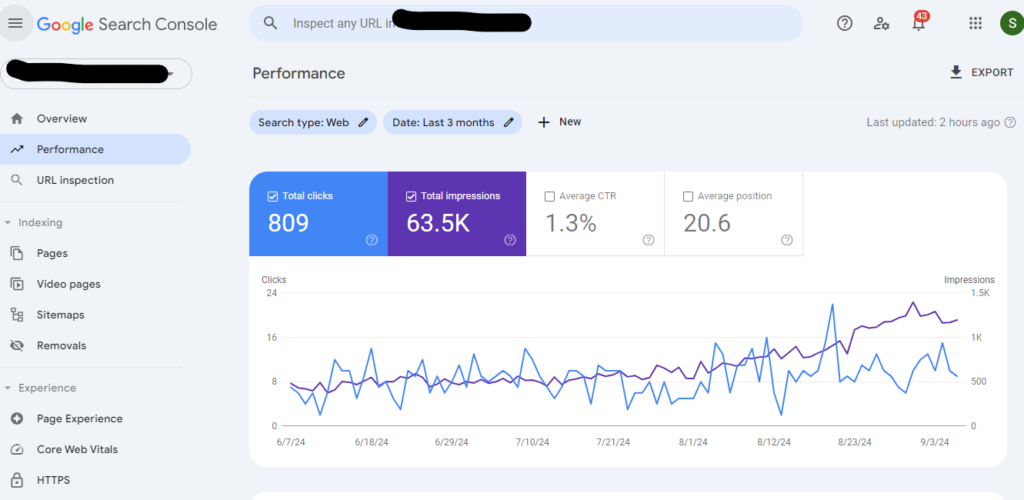
- Use Google Search Console: GSC gives you insights into the search queries that are already driving traffic to your site. Pay attention to your top-performing keywords as well as terms where you rank between 11 and 20—these are opportunities to improve.
- Ahrefs or SEMrush: If you have access to premium tools, these platforms allow you to see a comprehensive list of keywords you're ranking for, how much traffic they're bringing, and potential opportunities to rank higher.
- Target Gap Keywords: Look for keywords where you’re on the cusp of ranking in the top 10. These "gap keywords" can be improved through small content tweaks or strategic optimization.
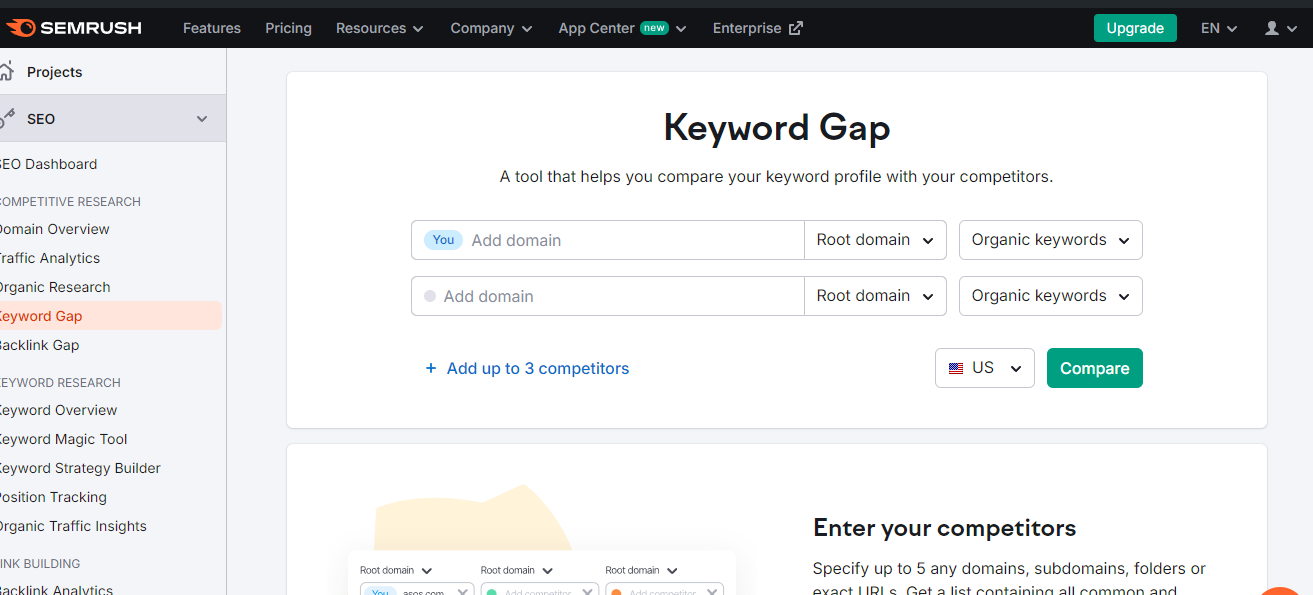
Pro Tip: You can often gain quick wins by optimizing content around keywords you already rank for, instead of focusing solely on new terms.
Step 3: Use Keyword Research Tools
Now it’s time to dive into more advanced methods using keyword tools to expand your list and gather valuable data like search volume, competition, and trends. Here’s a breakdown of the tools you should use:
| Paid Keyword Research Tools | Free Keyword Research Tools |
| SEMrush | Google Keyword Planner |
| Ahrefs | Ubersuggest |
| Moz Keyword Explorer | Google Trends |
| Serpstat | Keyword Sheeter |
| KWFinder | Answer the Public |
| SpyFu | Soovle |
| Majestic | Keyword Surfer |
| Wordtracker | Keyworddit |
| GrowthBar | QuestionDB |
| Keyword Tool Pro | Bulk Keyword Generator |
| Long Tail Pro | Google Search Console |
| SE Ranking | WordStream Free Keyword Tool |
| CognitiveSEO | Keyword Generator by Ahrefs |
| MarketMuse | AlsoAsked |
| BuzzSumo | Free SERP Checker (SERPChecker.com) |
Tool 1 : Semrush Keyword Research Tools
Semrush is ideal for finding not only keywords but also understanding competitor strategies. You can identify keyword gaps and find keyword difficulty scores to assess how hard it will be to rank.
Tool 2 : Google Search Console
GSC is crucial for analyzing existing traffic, understanding search performance, and seeing which keywords need more focus. For any ongoing SEO strategy, it’s a must.
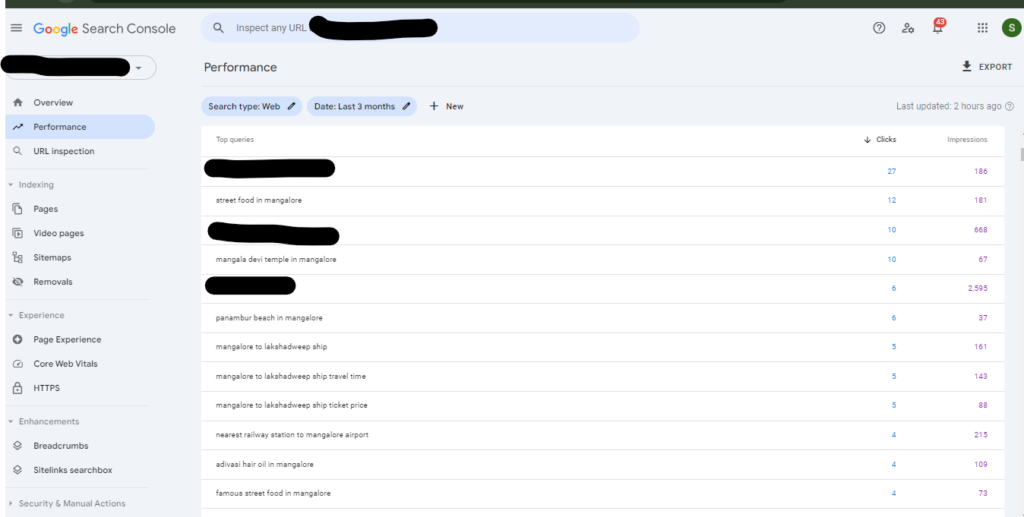
Tool 3 : Google Keyword Planner
Although Google Keyword Planner is mainly for paid ads, it’s a great free tool for discovering new keyword opportunities, getting search volume estimates, and competition levels.
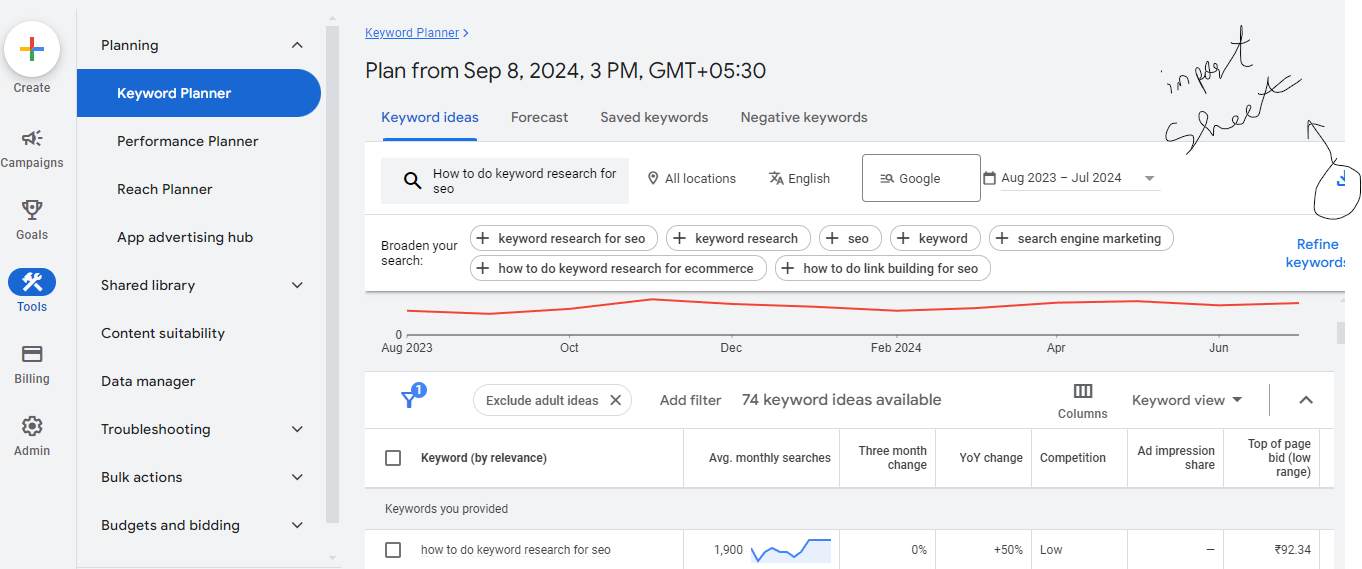
Tool 4 : SERP Gap Analyzer
Use tools like Ahrefs’ SERP Gap Analyzer to discover keywords your competitors rank for that you don’t. These untapped opportunities can give you a competitive edge.
Tool 5 : Google Trends
This tool helps you identify rising trends and analyze search term popularity over time. If you’re in a fast-moving industry like technology or fashion, Google Trends can help you stay ahead of your competition.
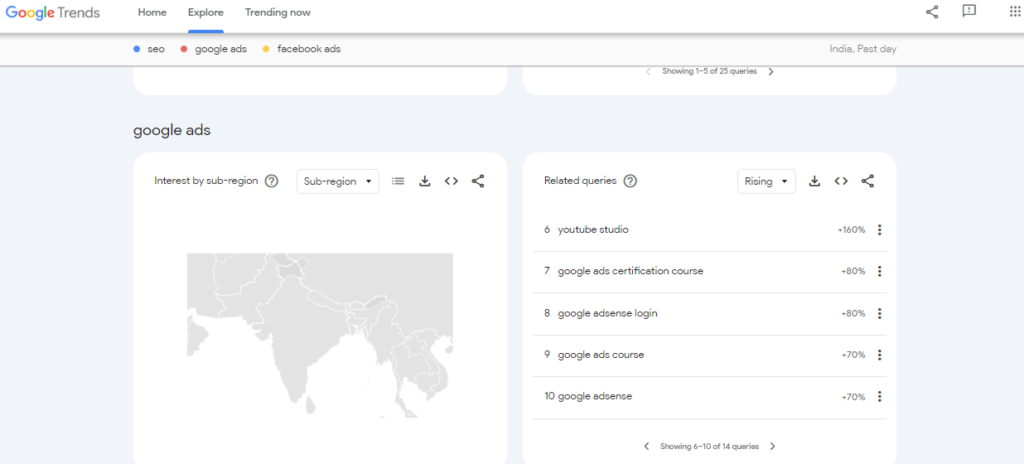
Step 4 : Study Your Niche and Competitors
Analyzing your niche and competition is essential. Start by looking at who your top competitors are and what keywords they are ranking for.
How to Study Competitors:
- Identify Direct Competitors: Use Semrush or Ahrefs to analyze which websites are competing for the same keywords. By studying their content, backlinks, and keyword strategies, you can uncover gaps.
- Content Opportunities: If you see that a competitor ranks for a keyword with weak or outdated content, create better, more detailed content to outrank them.
Step 5: Find Related Search Terms
Google’s “Related Searches” is an often overlooked but highly valuable resource. Scroll to the bottom of the search results page to find closely related keywords that people are searching for.
How to Use Related Terms:
- These terms can help you expand your seed keyword list and discover long-tail keywords you may have missed.
- Look for phrases with clear user intent and consider how you can address those queries in your content.

Step 6 : Analyze Keyword Intent and Search Intent
Not all keywords are created equal. Before targeting a keyword, it’s critical to verify the intent behind it.
Understanding Search Intent:
- Informational: Users are looking for knowledge, such as “how to fix a leaky faucet.”
- Transactional: Users are ready to make a purchase or take action, like “buy running shoes online.”
- Navigational: Users are trying to get to a specific website or page, like “Nike store near me.”
By verifying the search intent of a keyword, you can create content that satisfies the user’s query and improves your chances of ranking highly.
How to Analyze and Choose the Right Keywords
Selecting the right keywords involves analyzing various factors to ensure you’re targeting terms that can drive meaningful traffic and conversions. Here’s how to evaluate and choose keywords effectively.
Search Volume and Keyword Difficulty
When evaluating keywords, two critical metrics to consider are search volume and keyword difficulty.
- Search volume indicates how many times a particular keyword is searched per month. While high-volume keywords might seem attractive, they often come with more competition.
- Keyword difficulty measures how challenging it is to rank for a specific keyword, taking into account the strength of competing pages.
Balancing search volume and difficulty is key to targeting keywords that offer a realistic chance of ranking while still attracting substantial traffic.
Traffic Potential and CPC
Traffic potential measures the total amount of traffic a keyword can drive, beyond just its search volume. Some keywords may have a lower volume but generate significant traffic if they cover a broad topic.
Cost Per Click (CPC) indicates how much advertisers are willing to pay for a click on ads targeting that keyword. Higher CPC keywords often signify commercial intent, meaning users are more likely to convert. Identifying high-traffic keywords with strong CPC values can help you focus on terms that bring both traffic and revenue opportunities.
Cost-Benefit Analysis for Keywords
Performing a cost-benefit analysis for each keyword helps you evaluate its potential ROI. Consider factors like:
- Traffic volume: How much traffic can the keyword bring?
- Conversion potential: Will the keyword attract users who are likely to convert into customers?
- Content effort: How much effort and resources are required to create content that can rank for this keyword?
This analysis ensures you focus on profitable keywords that deliver tangible benefits for your business.
Prioritizing Keywords Based on Business Potential
Not all keywords hold the same value for your business. It’s crucial to prioritize keywords that align with your business goals. To do this, assess the business potential of each keyword:
- Does the keyword align with your core products or services?
- Can it attract your target audience at different stages of the buyer’s journey?
- Is the keyword likely to drive conversions or revenue?
By focusing on keywords with the highest business relevance, you ensure your SEO efforts directly contribute to your goals.
Long-Tail vs. Short-Tail Keywords
Short-tail keywords are broad search terms like “SEO” or “marketing,” which often have high search volume but fierce competition. Long-tail keywords are more specific phrases, such as “how to do keyword research for SEO,” that typically have lower search volume but more precise user intent and easier ranking opportunities.
Learning how to research long-tail keywords can help you attract a more targeted audience. Although they generate less traffic individually, long-tail keywords often have higher conversion rates because they address specific needs.
Targeting Keywords for SEO Success
Once you’ve identified the right keywords, the next step is implementing them strategically. Proper targeting ensures your content aligns with both user intent and SEO best practices. Here’s how to do it.
Mapping Keywords to Content
Keyword mapping involves assigning specific keywords to relevant pages on your site. This process ensures that each keyword aligns with a piece of content that addresses the searcher’s intent.
- Start by organizing your keywords into groups based on themes or topics.
- Next, map each group of keywords to existing or new pages that match the search intent behind those terms.
- Ensure you’re not targeting the same keyword across multiple pages, which can lead to keyword cannibalization and harm your rankings.
This approach makes your content strategy more focused and increases the likelihood of ranking for target keywords.
Optimizing Content with Keywords
After mapping, the next step is optimizing your content for those keywords. Here’s how to do it effectively:
- Primary keyword: Use your primary keyword naturally in the title, URL, meta description, headings, and throughout the body of the content.
- Secondary keywords: Sprinkle related terms and semantic keywords into subheadings and body content to give search engines a more comprehensive understanding of your page.
- Avoid overstuffing; keyword density should feel natural to both readers and search engines.
The goal is to make sure your content is valuable while still aligning with SEO best practices.
Focus on Content Quality and Usability
Content quality is now one of the most important ranking factors for search engines. High-quality content not only keeps readers engaged but also signals to search engines that your page is worth ranking.
- Usability: Structure your content to be skimmable by using short paragraphs, bullet points, and clear subheadings. Make sure your site loads quickly and is mobile-friendly.
- Value: Aim to provide actionable, insightful, or entertaining information that answers the user’s query better than your competition.
Focusing on content quality ensures that users stay on your page longer, reducing bounce rates and increasing the chances of ranking higher.
Using Primary and Secondary Keywords
When targeting keywords, it’s essential to use a combination of primary and secondary keywords. Your primary keyword is the main term you’re optimizing the page for, while secondary keywords are related terms or variations that support the primary keyword.
- Use the primary keyword in critical places like the title tag, H1, and the first 100 words.
- Place secondary keywords throughout the content in a natural way, including in subheadings and supporting sections.
Balancing primary and secondary keywords helps search engines better understand the context of your content, increasing the chances of ranking for a broader range of queries.
Advanced Keyword Research Techniques
When you’ve covered the basics, advanced keyword research techniques become the real game-changer. These strategies can help you discover untapped opportunities, predict trends, and target valuable keywords that will increase your organic traffic exponentially.
Find and Use Semantic Keywords
Semantic keywords are related terms that give search engines a clearer understanding of your content’s topic. Search engines now look beyond exact keywords and focus more on the context of the entire content. Incorporating semantic keywords not only improves your ranking but also ensures that your content is relevant to a broader set of queries.
Here’s how to implement semantic keywords effectively:
- Identify relevant semantic keywords: Use tools like LSI Graph, Google’s Related Searches, or Ubersuggest to discover terms closely connected to your primary keyword.
- Structure content around intent: Place semantic keywords naturally throughout your content. For example, if you’re writing about “how to do keyword research for SEO,” include related terms like “keyword analysis tools,” “search intent,” and “organic traffic growth” in your headings and body copy.
- Balance for readability: While incorporating semantic keywords, make sure your content still reads naturally for humans. It’s crucial to avoid keyword stuffing, as this can harm your SEO efforts and user experience.
By using semantic keywords, you align your content with how search engines understand language. This can boost your chances of ranking for related search terms, not just the exact match keyword, which increases your reach and visibility in search engine results.
Anticipate Keyword Trends
Anticipating keyword trends is about staying one step ahead of the competition. It helps you target topics that are on the rise, giving you a head start on driving traffic before these keywords become highly competitive.
Here’s how you can stay on top of keyword trends:
- Use Google Trends: This tool is incredibly valuable for spotting growing interest in specific search terms. You can track the rise of search volume over time and see which keywords are gaining traction in your niche.
- Monitor industry shifts: Regularly check industry news, social media, and forums where your audience hangs out. New trends often emerge from changing consumer needs, market conditions, or technological advancements.
- Seasonal keywords: Some keywords peak at specific times of the year. By planning content around these seasonal keywords early, you can maximize your traffic during high-demand periods.
By focusing on future trends, you can capture early momentum and establish authority in your niche before the competition. This proactive approach will keep your content relevant and fresh in the eyes of both search engines and your audience.
Keyword Research for Organic Traffic Growth
Your ultimate goal is to drive organic traffic—and keyword research is at the heart of this strategy. To succeed, you need a clear approach that balances both volume and relevance while also focusing on long-term growth.
Here’s how to drive more organic traffic through smarter keyword research:
- Prioritize high-impact keywords: Look for keywords with high search volume but moderate competition. These terms give you the best opportunity to rank and attract traffic. Tools like Ahrefs or SEMrush can help you filter out these opportunities.
- Target long-tail keywords: Long-tail keywords (e.g., “best SEO tools for beginners” rather than just “SEO tools”) are often less competitive and tend to attract visitors with a more specific intent. Although these keywords may have lower search volume, they typically result in higher conversion rates.
- Analyze user intent: Ensure the keywords you target match the intent behind the search. Whether users are looking for information, making comparisons, or ready to purchase, aligning your content with their intent will help improve rankings and drive more qualified traffic.
With the right keyword research, you’re not just driving random traffic—you’re bringing in targeted visitors who are more likely to engage with your content, convert, and become loyal customers. Organic traffic growth is a long-term process, and selecting the right keywords at the start is critical to your success.
How to Monitor and Maintain Keyword Rankings
After you’ve implemented your keyword strategy, the real work begins—monitoring and maintaining your keyword rankings. SEO is a dynamic process, and what works today might need adjustment tomorrow. Regular tracking helps you stay competitive and ensures your efforts continue to drive results.
Evaluate Keyword Performance Over Time
Evaluating keyword performance is essential for understanding the effectiveness of your SEO efforts. It allows you to see which keywords are driving traffic, conversions, and visibility. Here’s how to effectively monitor keyword performance over time:
- Use tracking tools: Platforms like Google Search Console, SEMrush, or Ahrefs provide detailed data on your keyword rankings. You can track changes in position, clicks, and impressions to get a sense of how well your keywords are performing.
- Focus on key metrics: Pay attention to click-through rate (CTR), organic traffic, and conversion rates for each keyword. High rankings are great, but if they’re not driving qualified traffic, they’re not providing value.
- Compare rankings to competitors: See where your competitors rank for similar keywords. If their performance outpaces yours, analyze their strategies to identify opportunities for improvement.
Why it matters: Regular evaluation helps you identify which keywords need more attention, where your SEO efforts are paying off, and what adjustments are required to maintain or boost rankings. This ensures that your strategy stays aligned with your business goals.
How to Maintain and Improve Keyword Rankings
Maintaining and improving keyword rankings requires ongoing effort and optimization. SEO isn’t a “set it and forget it” task—continuously improving your strategy is key to staying ahead in search engine results. Here’s how you can maintain and even boost your rankings:
- Update content regularly: Fresh, relevant content signals to search engines that your site is actively maintained. Periodically update your key pages with new data, insights, and trends to keep them relevant.
- Build high-quality backlinks: Backlinks remain one of the strongest ranking factors. Focus on acquiring authoritative, relevant backlinks from respected sites in your niche. This not only helps you maintain rankings but also improves them over time.
- Improve user engagement: Factors like dwell time (how long users stay on your page) and bounce rate (how quickly they leave) impact rankings. Make sure your content is engaging and answers users’ questions thoroughly, encouraging them to stay longer and explore more of your site.
- Optimize for search intent: As search engines evolve, they focus more on user intent. Ensure that your content matches what users are looking for at every stage of the buyer’s journey, from informational to transactional intent.
- Expand on long-tail keywords: As you start ranking for more competitive keywords, continue to target long-tail variations to capture additional traffic. These terms often have less competition and bring in highly targeted visitors.
By consistently updating your content, building authority, and focusing on user engagement, you’ll not only maintain your current rankings but also improve them over time. SEO is a marathon, not a sprint, and ongoing efforts are essential for long-term success.
Key 3 Takeaways and Best Practices while doing Keyword Research
Now that you’ve walked through the step-by-step process of keyword research, let’s summarize the most crucial points and best practices. Successful SEO is about consistency, adaptation, and refining your approach based on evolving data.
Takeway 1 : The Importance of Continuous Keyword Research
SEO is never static—neither are keywords. Continuously researching and updating your keywords is critical to staying relevant in a constantly changing landscape. Here’s why ongoing research matters:
- Search trends evolve: User behavior and search trends shift over time, so the keywords that worked well last year may not be as effective today.
- Competitor dynamics: Your competitors are likely improving their keyword strategies, which can impact your rankings. Keeping an eye on new opportunities and gaps can give you an edge.
- Content optimization: Regular keyword research helps you identify underperforming content, offering opportunities to refresh it with new or trending keywords.
Best Practice: Make keyword research an ongoing part of your SEO strategy. Set up regular audits and updates to stay ahead of the competition.
Takeaway 2 : How to Adapt to Changing Search Trends
Search engines like Google are constantly updating their algorithms to deliver better results to users. Understanding and adapting to these changes is key to maintaining visibility.
- Stay updated on algorithm changes: Follow SEO news and updates to understand how changes impact ranking factors and adjust your strategy accordingly.
- Incorporate voice search and mobile SEO: As voice search and mobile usage rise, optimize your content for these formats by targeting more natural, conversational queries.
- Leverage emerging trends: Keep an eye on tools like Google Trends to spot upcoming keyword trends early, allowing you to pivot quickly and capture new traffic opportunities.
Best Practice: Be flexible and proactive. The quicker you adapt to changes, the more effectively you can capitalize on emerging trends and maintain your rankings.
Takeaway 3: Recap of the Best Keyword Research Strategies
To wrap things up, here are the key strategies that will ensure your keyword research efforts yield long-lasting results:
- Start with seed keywords: Begin with brainstorming core topics relevant to your business.
- Use keyword research tools: Tools like Google Keyword Planner, SEMrush, and Ahrefs are invaluable for discovering high-potential keywords.
- Analyze your competition: See what keywords your competitors are ranking for, and use that data to find gaps or opportunities.
- Focus on search intent: Ensure your keywords align with what users are really searching for, whether it’s information, solutions, or purchases.
- Target long-tail keywords: These often have lower competition and can bring in highly targeted traffic.
- Prioritize keywords based on business potential: Focus on keywords that are not only easy to rank for but are also relevant to your business goals.
Best Practice: Use these strategies as the foundation of your SEO efforts and continually refine them based on performance data and new trends.
